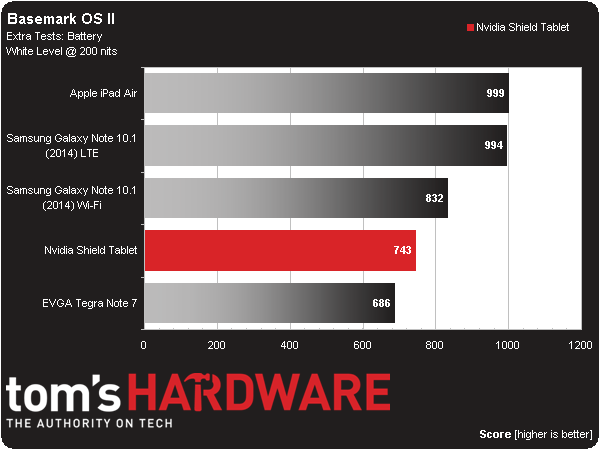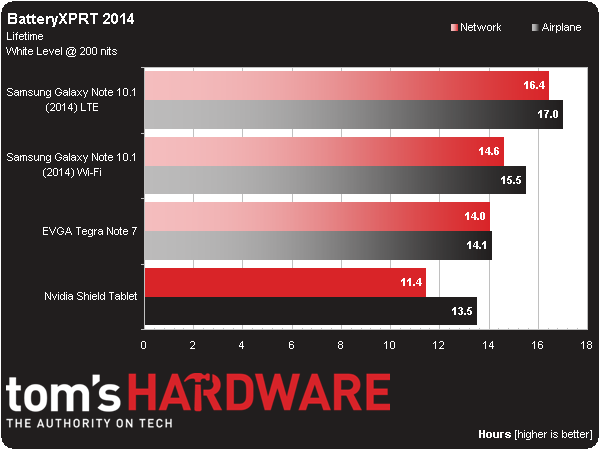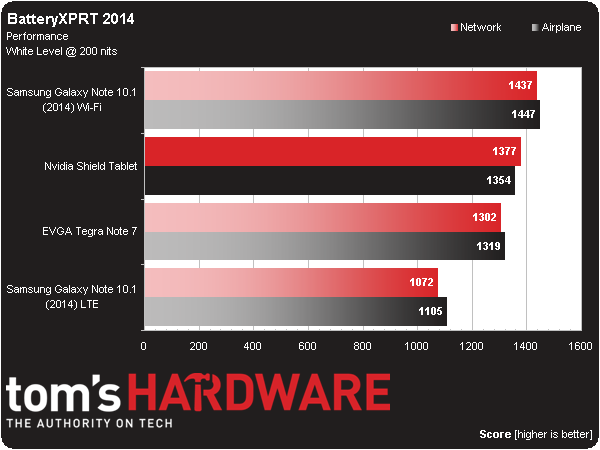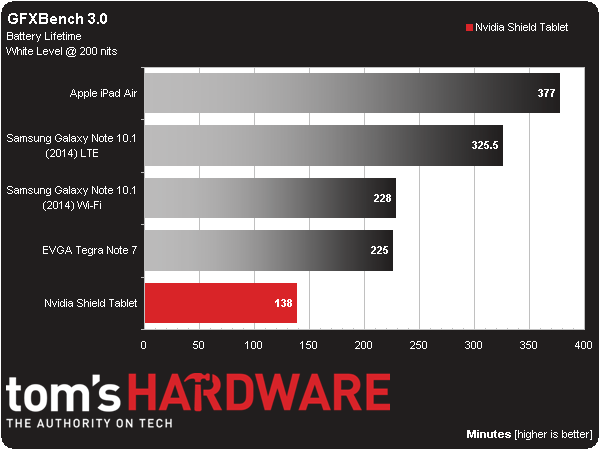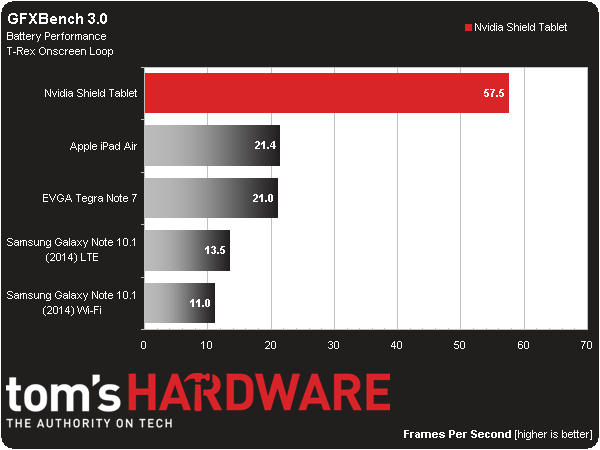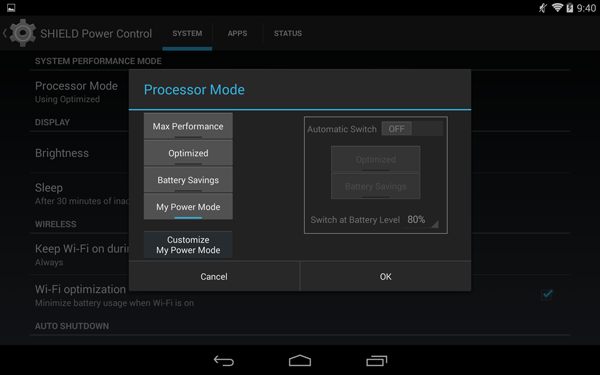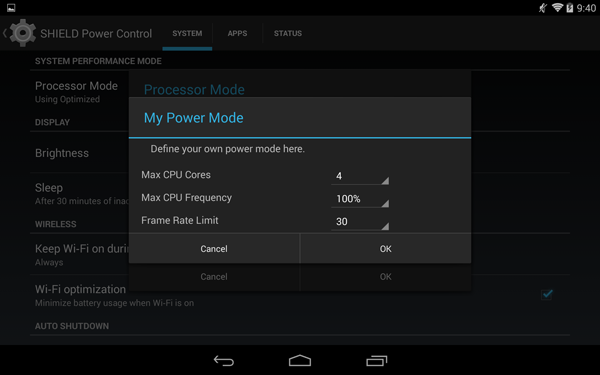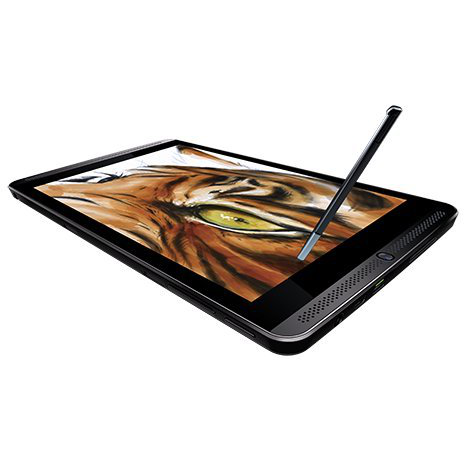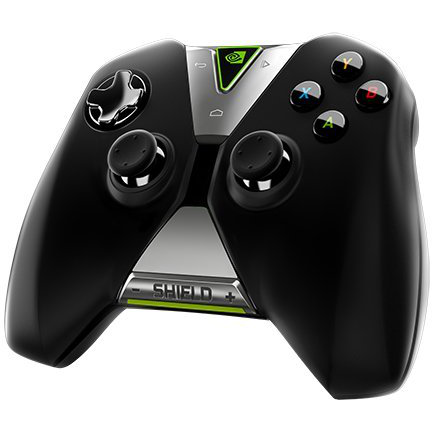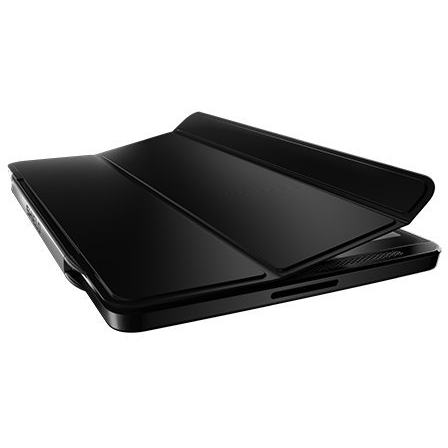Nvidia Shield Tablet And Shield Controller Review
The Shield Tablet, powered by Nvidia’s Tegra K1 SoC, deftly handles browsing and media playback duties. Combining it with the wireless Shield Controller transforms the 8-inch device into an exciting mobile gaming platform.
Results: Battery And Throttling
Basemark OS II Full (Anti-Detection)
The Basemark OS II battery test scores are derived by repeatedly running the devices until enough data has been collected to determine the drain rate of the device.
Basemark OS II primarily works the CPU, leaving most of the GPU powered down. In this benchmark, the Shield Tablet outscores the Tegra Note 7. Even though the Shield’s -A15 cores are running at a higher frequency, moving to the 28nm HPM process and updated revision-three cores nets more performance while using less power. This is even more impressive when we consider screen area and battery size scaling. All else being equal, the Shield Tablet’s larger screen and small increase in battery size means it should only get ~88% of the battery life of the Tegra Note 7, not 8% more.
The two Samsung tablets and the iPad Air are all ~10” devices with significantly larger batteries, skewing battery life results in their favor.
BatteryXPRT 2014
BatteryXPRT 2014 is a specialized battery testing application for Android devices that provides users with an "expected" Lifetime score, as well as an overall Performance score. The test has two variations: Network-Connected and Airplane Mode. It’s modeled in part after the MobileXPRT benchmark, which consists of ten real-world test scenarios encompassing various photo operations and encryption.
Airplane mode estimates battery life for a device with no Internet connectivity, and Network mode estimates battery life for a device connected to the Internet via Wi-Fi or cellular data connection.
This benchmark also primarily uses the CPU, but mixes in light GPU work. In Airplane mode, the Tegra Note 7 lasts just over one-half hour longer than the Shield Tablet, reversing the order from the Basemark OS II Battery test. It’s likely that the GPU is to blame, but we’ll need to see the results from GFXBench to confirm.
There’s a much more precipitous drop in battery life when turning Wi-Fi on. The two devices use different controllers, and the Broadcom chip in the Shield Tablet doesn’t appear to be as energy efficient. I’ve also noticed what I would consider excessive power drain during standby with Wi-Fi left on, which subjectively corroborates these results.
Get Tom's Hardware's best news and in-depth reviews, straight to your inbox.
The Shield Tablet turns in a slightly better performance than the Tegra Note 7, but curiously falls behind the Galaxy Note 10.1 Wi-Fi even though they posted similar scores in MobileXPRT.
GFXBench 3.0 Corporate
GFXBench's battery test measures battery life and performance stability by logging frame and battery discharge rate as the on-screen T-Rex test runs for 30 consecutive iterations. The results are given in two scores: estimated battery life in minutes and the number of frames rendered on the slowest test run (to gauge if a device is throttling).
GFXBench heavily stresses the GPU, and we see the power penalty paid for Kepler’s exceptional performance. The Shield Tablet only lasts for 2.3 hours, similar to a gaming laptop. While battery life is good while the CPU is under load, your gaming session won’t last very long on battery power.
Although time playing games away from a power outlet may be limited, your frame rates won’t be. Looping through T-Rex 30 times shows no hint of thermal throttling.
Nvidia does provide a way to improve battery life with the Processor Mode selection from within Settings. There are three preset options ranging from max performance to max battery life. There’s also an option to switch between these presets automatically at a preset battery level.
The utility also provides the ability to customize the settings. The number of CPU cores can be set to either two or four, and the peak CPU frequency is adjustable in 10% increments. The more intriguing setting is for limiting the maximum frame rate to 20, 30, 45 or 60FPS.
Leaving all four CPU cores active at their top frequency, I set the frame rate limit to 30 and reran GFXBench 3.0. With about half as many frames to draw, battery life improved from 138 minutes (2.3 hours) to 315 minutes (5.25 hours), a 2.28x increase with playable performance. Adjusting this setting substantially increases battery life and makes the Shield Tablet more viable as a mobile gaming device.
Current page: Results: Battery And Throttling
Prev Page Results: Display Measurements Next Page A Multifaceted Shield Worth Carrying Into Battle-
blubbey Those GPGPU benchmarks are ridiculous in comparison. It looks like a great bit of kit from what I've seen so far. A die shrunk Maxwell should be fantastic. Maybe even a lower clocked version just for power consumption? It'll still perform as well, if not better than the K1 at 750MHz (assuming 2 SMMs) I'd assume.Reply -
Memnarchon "Based on these results, Tegra K1 must be “a neural net processor; a learning computer” sent back through time to destroy all of the other SoCs that could lead a rebellion in the post-apocalyptic future."Reply
Lol this is epic! xD
Anyway, great and unique review. Especially for the so many GPGPU benchmarks.
Nvidia tablet at $299 seems to be a great buy. -
aberkae If maxwell brings double the performance per watt on the same node the next tegra chip on 20 nm node should be a home run for the companyReply -
deftonian Impressive, but I feel it's still missing that "umph" to get me to buy this and carry it around as an added device, next to my phone (Note 3). Maybe I just don't game enough on the android market or steam. Either way, I think it is impressive for a mobile gaming device and all the things it offers. I think they've started a great line and hope it grows into a successful tablet/gaming brand.Reply -
aberkae If maxwell brings double the performance per watt on the same node the next tegra chip on 20 nm node should be a home run for the companyReply -
gio2vanni86 The streaming a game while i'm at my friends house using my PC at home is what has me very interested. Plug into his TV and play amazing games he can only dream of. I'm in.Reply -
vithrell Just wait for Intel's Core M. It wont match the price (CPU alone will cost $300), but in fanless tablet form factor it wont have worthy competitor. Early GPU benchmarks give Core M 55k graphics score in Ice Storm, so more than 1.5x more power than Tegra K1. AND you can run full Windows on it. I wish Nvidia took x86 path with its cpu cores.Reply
